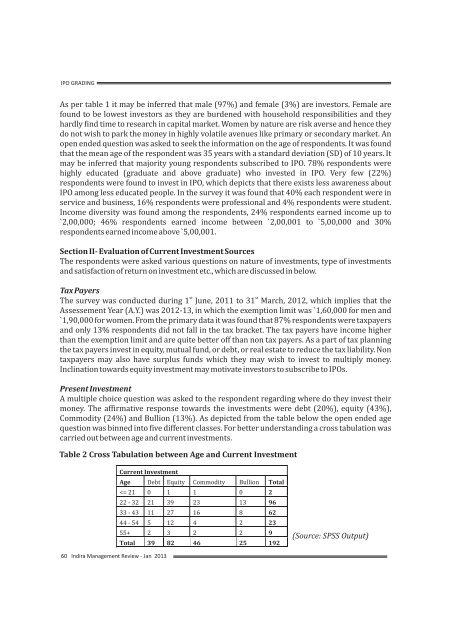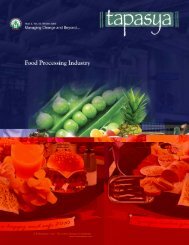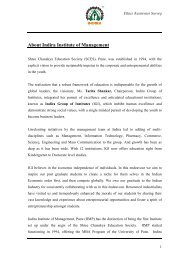IMR JAN 2013 - Indira Institutes
IMR JAN 2013 - Indira Institutes
IMR JAN 2013 - Indira Institutes
You also want an ePaper? Increase the reach of your titles
YUMPU automatically turns print PDFs into web optimized ePapers that Google loves.
IPO GRADINGAs per table 1 it may be inferred that male (97%) and female (3%) are investors. Female arefound to be lowest investors as they are burdened with household responsibilities and theyhardly find time to research in capital market. Women by nature are risk averse and hence theydo not wish to park the money in highly volatile avenues like primary or secondary market. Anopen ended question was asked to seek the information on the age of respondents. It was foundthat the mean age of the respondent was 35 years with a standard deviation (SD) of 10 years. Itmay be inferred that majority young respondents subscribed to IPO. 78% respondents werehighly educated (graduate and above graduate) who invested in IPO. Very few (22%)respondents were found to invest in IPO, which depicts that there exists less awareness aboutIPO among less educated people. In the survey it was found that 40% each respondent were inservice and business, 16% respondents were professional and 4% respondents were student.Income diversity was found among the respondents, 24% respondents earned income up to`2,00,000; 46% respondents earned income between `2,00,001 to `5,00,000 and 30%respondents earned income above `5,00,001.Section II- Evaluation of Current Investment SourcesThe respondents were asked various questions on nature of investments, type of investmentsand satisfaction of return on investment etc., which are discussed in below.Tax PayersststThe survey was conducted during 1 June, 2011 to 31 March, 2012, which implies that theAssessement Year (A.Y.) was 2012-13, in which the exemption limit was `1,60,000 for men and`1,90,000 for women. From the primary data it was found that 87% respondents were taxpayersand only 13% respondents did not fall in the tax bracket. The tax payers have income higherthan the exemption limit and are quite better off than non tax payers. As a part of tax planningthe tax payers invest in equity, mutual fund, or debt, or real estate to reduce the tax liability. Nontaxpayers may also have surplus funds which they may wish to invest to multiply money.Inclination towards equity investment may motivate investors to subscribe to IPOs.Present InvestmentA multiple choice question was asked to the respondent regarding where do they invest theirmoney. The affirmative response towards the investments were debt (20%), equity (43%),Commodity (24%) and Bullion (13%). As depicted from the table below the open ended agequestion was binned into five different classes. For better understanding a cross tabulation wascarried out between age and current investments.Table 2 Cross Tabulation between Age and Current InvestmentCurrent InvestmentAge Debt Equity Commodity Bullion Total








